Buxton Civic Association is pushing for a new wave of community action to clean up Buxton Beach
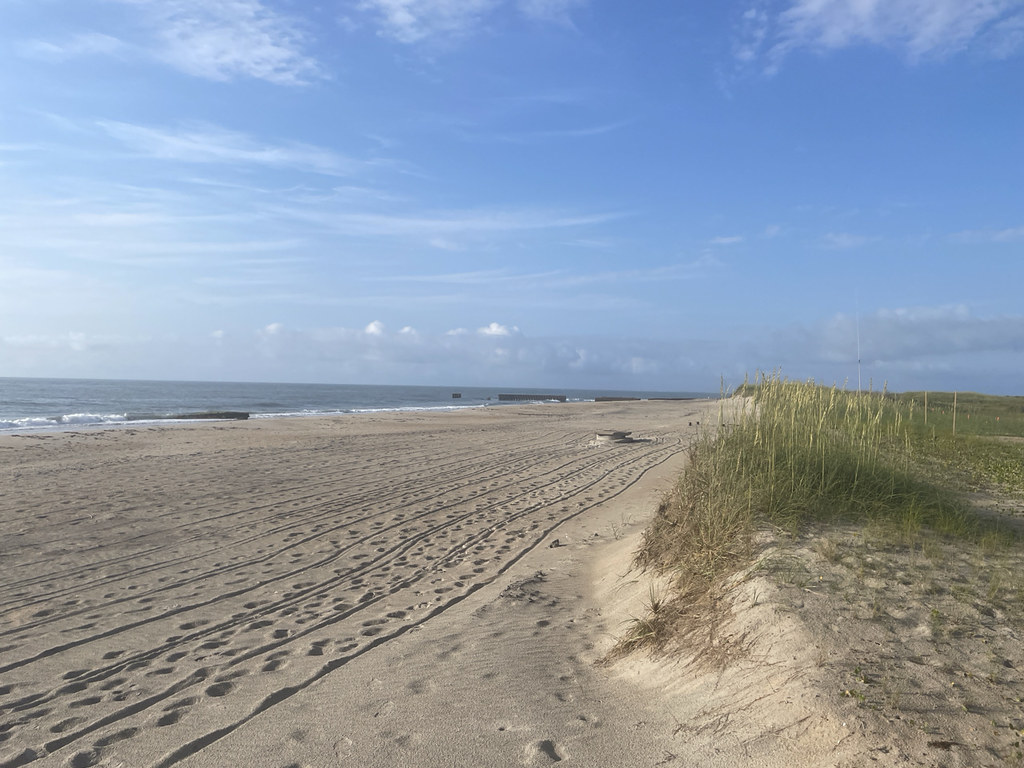
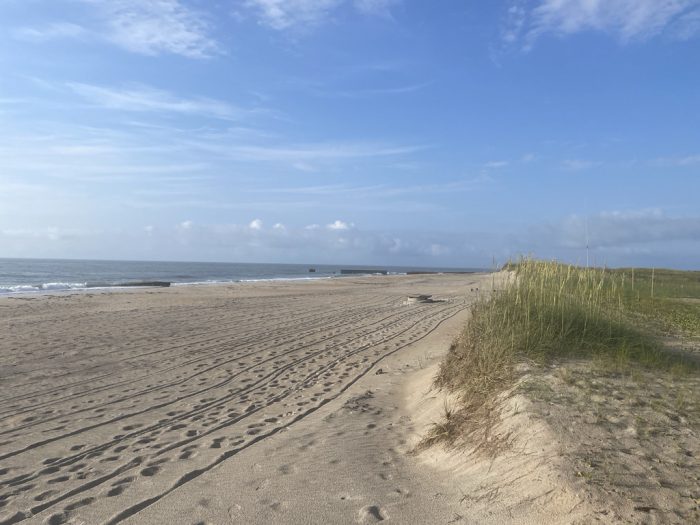
The Buxton Civic Association (BCA) held its monthly public meeting on Thursday 11 July and urged attendees to keep the momentum going by continuing to demand action on Buxton Beach.
An initial email and letter campaign was launched in March and the BCA hopes that a second wave of letters, emails, phone calls and even social media posts will further put pressure on lawmakers and agencies that can influence the cleanup of a 500-metre stretch of Buxton coastline.

“When this all started, it was so bad for people in the beginning that they were sick of hearing from you,” board member Heather Gray Jennette said at the meeting. “I think hearing from the community and letting them know ‘you may have forgotten, but we haven’t,’ will lead to faster action.”
“There’s a lot going on right now, but it’s a super frustrating ‘hurry up and wait’ process,” she added. “And until they get tired of us knocking down their electronic doors, it’s going to stay that way. So we’re hoping for another round of letters, emails or phone calls.”
A small section of Buxton Beach has been closed since September 2023 after two offshore hurricanes struck the Outer Banks, exposing abandoned infrastructure at the former military base and occasionally releasing the smell of petroleum into the air.
The parties agree that two agencies – the U.S. Army Corps of Engineers (Corps) and the U.S. Coast Guard – are responsible for the debris left behind and the cleanup of the shoreline. The petroleum odors and petroleum contaminated soils (PCS) fall under the U.S. Army Corps of Engineers’ Formerly Used Defense Site (FUDS) program, as the former Buxton military base was declared a FUDS site in 1998.

Although exposed infrastructure and the smell of petroleum have been sporadic problems since fall 2023, the problems only gained local and even national attention following a major public outcry in February and March.
Several public meetings were held during the spring, including one hosted by the National Park Service in March and one hosted by the Corps in May. The Corps also began taking steps to improve communication with the local community, including the future creation of a restoration advisory board.
According to a 1998 Corps procedures manual and a 2007 U.S. Secretary of Defense manual, the purpose of a Restoration Advisory Board (RAB) is to provide a channel of communication between local communities and the agencies responsible for the rehabilitation of sites previously used by the Department of Defense (DoD).
The ball is slowly rolling to establish the Buxton RAB, but it may take several months for the RAB to bear fruit.
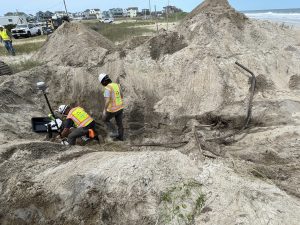
Back in May, the Corps also conducted its first remediation effort since the shoreline’s 2023 closure by removing an exposed 80-foot pipe believed to be at least a petroleum source. The Corps also took soil samples in the immediate area, although results from those tests may not be available for 60 to 90 days after the May test date.
Meanwhile, the National Park Service (NPS) conducted its own independent testing on May 24, after the pipe was removed. These tests were sent to a third-party lab, Environmental Chemists, Inc. The results were sent back to the NPS on June 27 by the North Carolina-based lab and stated that petroleum contamination in the immediate area was still above federal limits.
However, after the spring meetings, the first steps toward a restoration advisory board and the removal of the pipes, the current actions of the Corps and the U.S. Coast Guard are all focused on slow and steady testing.
From June 24 to 28, the Corps sent a team to the Buxton area to conduct geophysical work to identify any remaining subsurface fuel distribution components, such as pipes or fuel tanks.
“Identifying the anomalies can help us determine which areas we need to collect soil samples,” said Cheri Pritchard, media relations manager for the Corps’ Savannah District. “The results of the geophysical work will help us design the sampling plan that will be used in the comprehensive sampling effort. The contract to conduct this additional comprehensive sampling work is expected to be awarded in October 2024.”

In other words, the results of the geophysical work in June will lead to further testing plans in the fall. But even if a number of underground buildings are found – in addition to the known abandoned buildings – this is no guarantee that the above- and below-ground debris will be cleared.
According to the Corps, while the FUDS program can remove environmental hazards such as petroleum odor and sheen, it cannot be used to excavate and remove the remains of the military site unless they are directly identified as a petroleum source. The community and several stakeholders calling for action in Buxton Beach agree that this represents a major logical gap in responsibility.
In fact, the problems that have resurfaced over the past decade should have been properly and comprehensively addressed some 40 years ago, under the terms of a 1956 National Seashore Protection Service (NPS) special use permit that allows the military to borrow the National Seashore land as long as it is fully restored to its natural state once the military no longer needs the land. But that has not happened.
For example, the July 1985 Environmental Impact Assessment and Determination of No Significant Impact on the Department of Defense Environmental Restoration Program outlined the demolition work required for the former military site by stating: “The project includes the demolition of two concrete buildings, foundations and associated fences and walkways.”
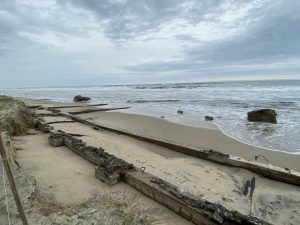
One of these two buildings was the terminal building, and according to a 1986 Army Corps of Engineers statement of work for demolition and removal of buildings, utilities, etc., the required work was completed. However, as was made clear during several winter and spring storms, the foundation of the terminal building was not completely removed.
The path to full rehabilitation is long and unclear, and this convoluted and drawn-out process is the main reason the BCA wants the community to once again raise a loud outcry.
“Our next action point is to start making some noise again,” said Heather Gray Jennette. “This all started in March and it seemed like something was really happening, but now it’s summer, the beach is covered again and everyone is busy doing other things, and we’re waiting for test results because we’re always waiting for test results.”
“We are stuck in this cycle and we feel like the only way to break out of it is to make noise.”
Hatteras Island Commissioner Danny Couch was also present at the July 11 meeting and explained that with the heated election season approaching, now is the perfect time to force lawmakers and elected officials to listen.
“You make a difference…I will always give the BCA credit for what goes on here,” Couch said. “There are two things that bureaucrats hate, and that is interference from legislators (and interference) from the public. The public has a lot of influence.”
“I would encourage you to think, ‘The clock is ticking… We started this a year ago and we got a lot of praise, but where is the action?’ There has been some activity (at Buxton Beach), but is the situation resolved? No, it is not.
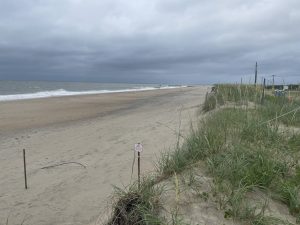
“As (board members) Brian, Heather, Wendi and others have always said, if you want to get something done, you have to be the squeaky wheel. You want to hear from the people, you want to hear from the voters … and I encourage you to keep up the pressure.”
Hoping that the community would follow suit, the BCA took steps to facilitate the letter-writing campaign by providing an email contact list as well as a draft letter that community members could adopt or copy and paste directly.
“They didn’t do anything until February, when all the (environmental problems) became visible and people started crying out… And even then, it took from February to May for people to listen to us and do something,” said board member Wendi Munden.
“And that’s part of our reasoning for ‘Let’s do another round of this.’ Because we’re in this summer wall and they’re not really hearing from us, even though they should.”
More information about Buxton Beach and how you can get involved
- Click here to view a BCA contact list. (Click here to access the contact list in Word format.)
- Sample letter templates to send to stakeholders can be found here (for a letter template created by Deb Hoyt) and here (for the letter template created by the BCA). (Click here to access the BCA letter template in Word format.)
- Click here for more letter writing tips and guidelines from the March email campaign.
- The Buxton Civic Association meets every first Thursday of the month at the old Buxton Volunteer Fire Department building next to Burrus Field. Up-to-date information from the Buxton Civic Association (BCA) can be found on the organization’s new website at BuxtonCivic.com or on the BCA’s official Facebook page.
- Remember that while the environmental problems at Buxton Beach are considered a threat to public safety and the environment, Of the 75 miles of the National Seashore, only three-tenths of a mile of shoreline is closed. In short, the public can continue to visit and enjoy Buxton and Hatteras Island in general. The main concern is that this issue needs to be addressed now before it potentially becomes a larger problem.




